Amsterdam and Poland 2017
Warsaw, Czestochowa and Krakow
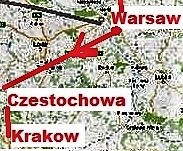
Day 8 Sunday, June 11
After another delicious breakfast and check out of our hotel, we
boarded our coach and left Warsaw about 9 o'clock and at 11:30, we
arrived at Czestochowa, the home of the Jasna Gora monastery (see my
model) and the shrine of the Black Madonna.
CZESTOCHOWA
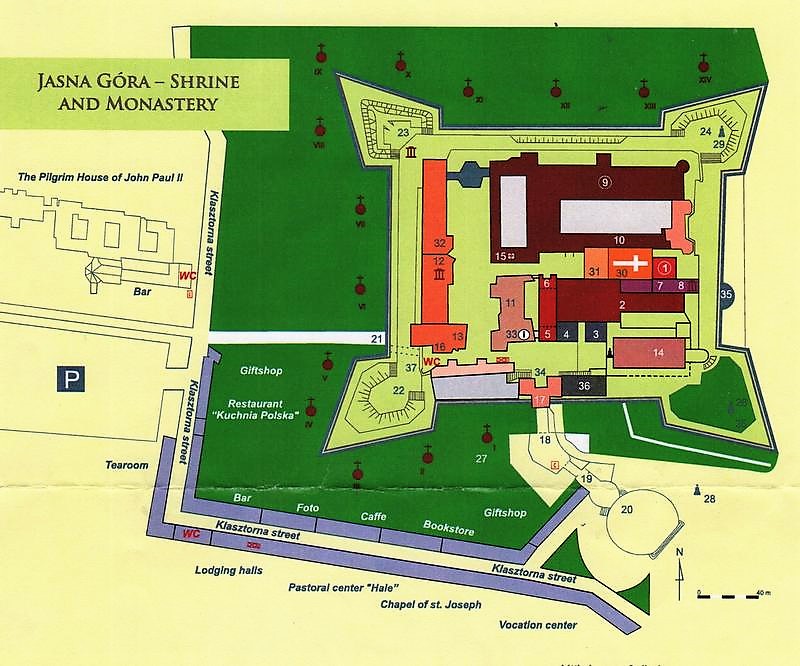 In
the first half of the 17th century, kings of the House of Vasa turned
the Jasna Gora Monastery into a modern Dutch-style fortress, which was
one of the pockets of Polish resistance against the Swedish armies
during Swedish invasion of Poland in 1655. The town of Częstochowa
itself was almost completely destroyed by Swedish soldiers.
In
the first half of the 17th century, kings of the House of Vasa turned
the Jasna Gora Monastery into a modern Dutch-style fortress, which was
one of the pockets of Polish resistance against the Swedish armies
during Swedish invasion of Poland in 1655. The town of Częstochowa
itself was almost completely destroyed by Swedish soldiers.
During the Great Northern War, Częstochowa was captured by Swedish
army on August 11,1702. In February1703, Swedes besieged the monastery,
but failed to seize it. In April 1705, the Swedes returned, and appeared
at the monastery again in September 1709. Unable to capture the
fortified stronghold, they looted villages in the area, set town of
Częstochowa on fire and left. On February 8, 1769, the monastery was
seized by rebels of the Bar Confederation. Soon the stronghold was
besieged by Russians. The Russians gave up their siege on January 15,
1771.
During the Partitions of Poland, Częstochowa was seized by the
Kingdom of Prussia in 1793, and incorporated into the province of South
Prussia. During the Napoleonic Wars, in 1807, Częstochowa became part of
the Duchy of Warsaw. In 1815, they became part of the
Russian-controlled Congress of Poland, in which it remained until World
War I. In 1809, the monastery was unsuccessfully besieged by Austrians.
On April 2, 1813, Jasna Góra was seized by the Russians, after a
two-week siege.
In early August 1914, Częstochowa was abandoned by
the Imperial Russian Army and first units of the German Army entered the
city during German occupation (1914 - 1918). Jasna Góra Monastery was,
since April 26, 1915, under control of Austria-Hungary after a personal
intervention of Emperor Franz Joseph I. The monastery was manned by
soldiers under Austrian Army Captain Josef Klettinger and remained under
Austrian control until November 4, 1918.
Up to World War II, like many other cities in Europe, Częstochowa
had a significant Jewish population. On April 9, 1941, a ghetto for Jews
was created. During World War II approximately 45,000 of Częstochowa's
Jews, almost the entire Jewish community living here, were killed by the
Germans.
THE BLACK MADONNA
The Monastery of Jasna Góra in Częstochowa, Poland, is the
third-largest Catholic pilgrimage site in the world. Home to the beloved
miraculous icon of Our Lady of Częstochowa, the monastery is also the
national shrine of Poland and the center of Polish Catholicism.
A ccording
to tradition, the icon of Jasna Góra was painted by the Luke the
evangelist on a tabletop built by Jesus himself, and the icon was
discovered by St. Helena, mother of Emperor Constantine and collector of
Christian relics in the Holy Land. The icon was then enshrined in the
imperial city of Constantinople according to the legend, where it
remained for the next 500 years.
ccording
to tradition, the icon of Jasna Góra was painted by the Luke the
evangelist on a tabletop built by Jesus himself, and the icon was
discovered by St. Helena, mother of Emperor Constantine and collector of
Christian relics in the Holy Land. The icon was then enshrined in the
imperial city of Constantinople according to the legend, where it
remained for the next 500 years.
In 803, the painting is said to have been given as a wedding
gift from the Byzantine emperor to a Greek princess, who married a
Ruthenian nobleman. The image was then placed in the royal palace at
Belz, (once part of Poland but now part of Ukraine),where it remained
for nearly 600 years.
Legend has it that during the looting of Belz, a mysterious
cloud enveloped the chapel containing the image. The painting was then
moved to Jasna Gora monastery in 1386.
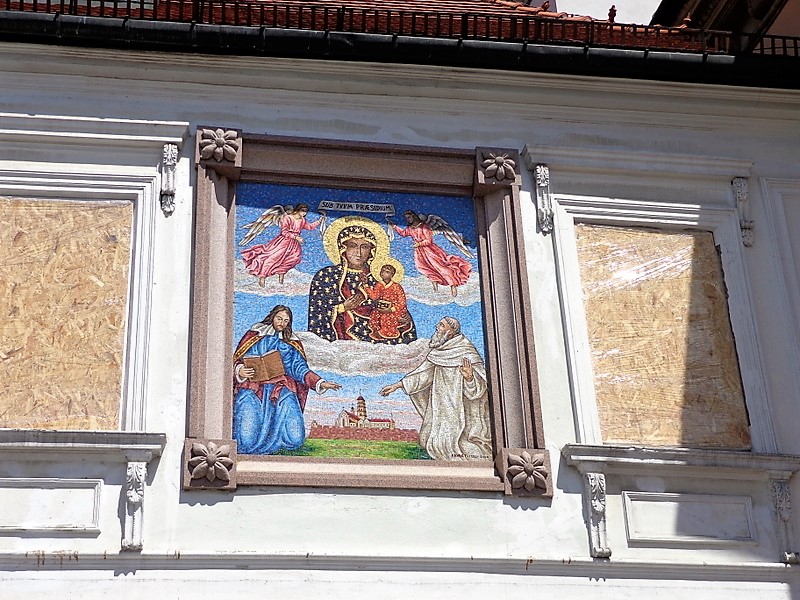 It is said that when the monks pulled the icon from the mud, a
miraculous fountain appeared, which they used to clean the painting. The
icon was repainted in Krakow, but both the arrow mark and the gashes
from the sword were left and remain clearly visible today.
It is said that when the monks pulled the icon from the mud, a
miraculous fountain appeared, which they used to clean the painting. The
icon was repainted in Krakow, but both the arrow mark and the gashes
from the sword were left and remain clearly visible today.
The miracle for which the Black Madonna of Częstochowa is most
famous occurred in 1655, when Swedish troops were about to invade
Częstochowa. A group of Polish soldiers prayed fervently before the icon
for deliverance, and the enemy retreated. In 1656, King John Casimir
declared Our Lady of Częstochowa "Queen of Poland" and made the city the
spiritual capital of the nation.
The Virgin again came to the aid of her people in 1920, when the
Soviet Russian Red Army gathered on the banks of the Vistula River,
preparing to attack Warsaw. The citizens and soldiers fervently prayed
to Our Lady of Częstochowa, and on September 15, the Feast of Our Lady
of Sorrows, she appeared in the clouds above Warsaw. The Russians were
defeated in a series of battles later dubbed the "Miracle at the
Vistula."
During Nazi occupation, Hilter prohibited pilgrimages to Jasna Góra,
but many still secretly made the journey. In 1945, after Poland was
liberated, half a million pilgrims journeyed to Częstochowa to express
their gratitude. On September 8, 1946, one and a half million
people gathered at the shrine to rededicate the entire nation to the
Immaculate Heart of Mary. During the Cold War, Jasna Góra was a center
of anti-Communist resistance.
.jpg)
The whole complex of Jasna Góra is extensive and rests on the top of
a hill. There are a number of buildings that surround the church (#2 on
map) itself which makes it difficult to photograph.
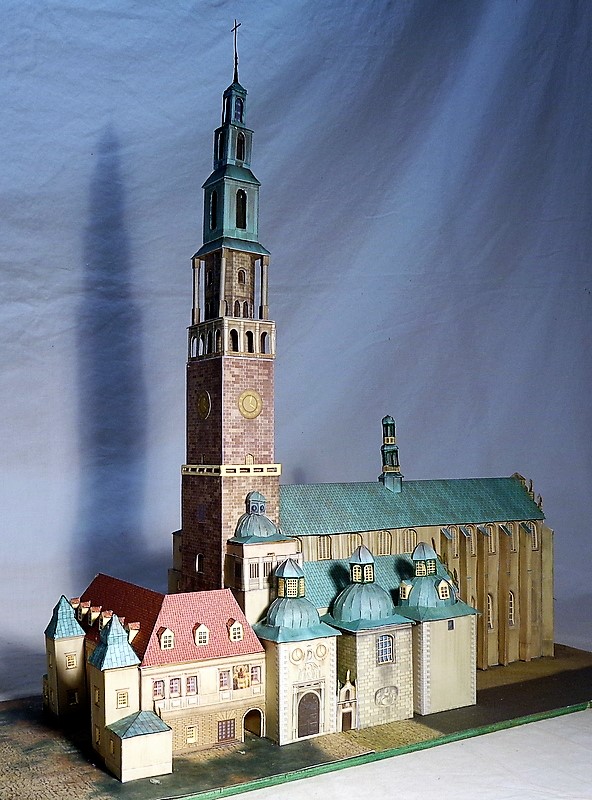
Here is a photo of my model which shows all of the details of the
church.
 Directly
in front of the church is a one-story building which houses some guest
apartments and the information office, (#11)thus there is no front
entrance.
Directly
in front of the church is a one-story building which houses some guest
apartments and the information office, (#11)thus there is no front
entrance.

The main entrance is on the right side (#5).

Above the entrance is the magnificent bell tower which extends to
347 feet. It was reconstructed in 1906; however, the bottom part dates
from 1714.
The second level contains four clocks, one
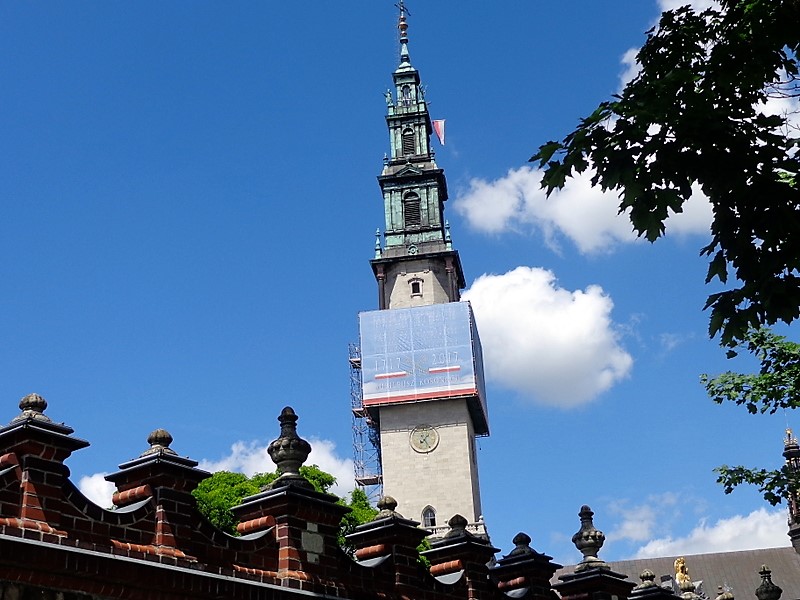 on each side, that mark
the passage of each 15 minutes with Marian melodies.
on each side, that mark
the passage of each 15 minutes with Marian melodies.
Inside the third level are statues of St. Paul the Hermit, St.
Florian, St. Casimir and the Saint-Queen Hedvig. This level was under
restoration with a scaffolding and a protective covering.
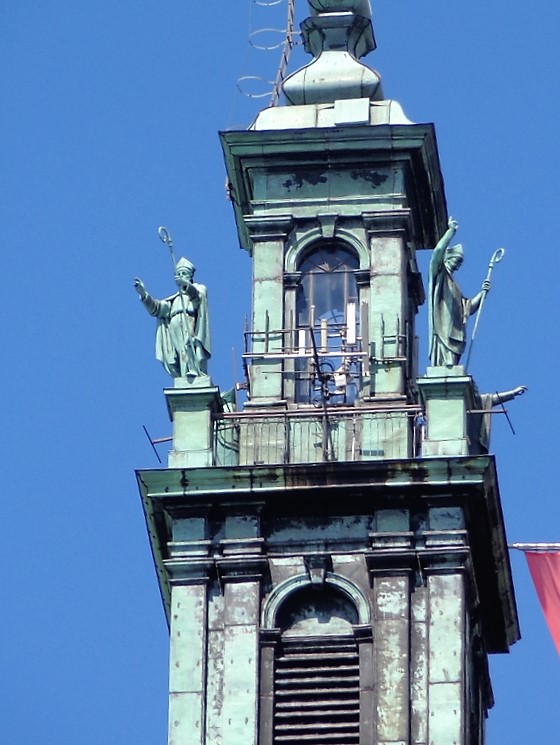
The fifth
level has statues of the church fathers St. Leo the Great, St. Gregory,
St. Augustine and St. Ambrose.
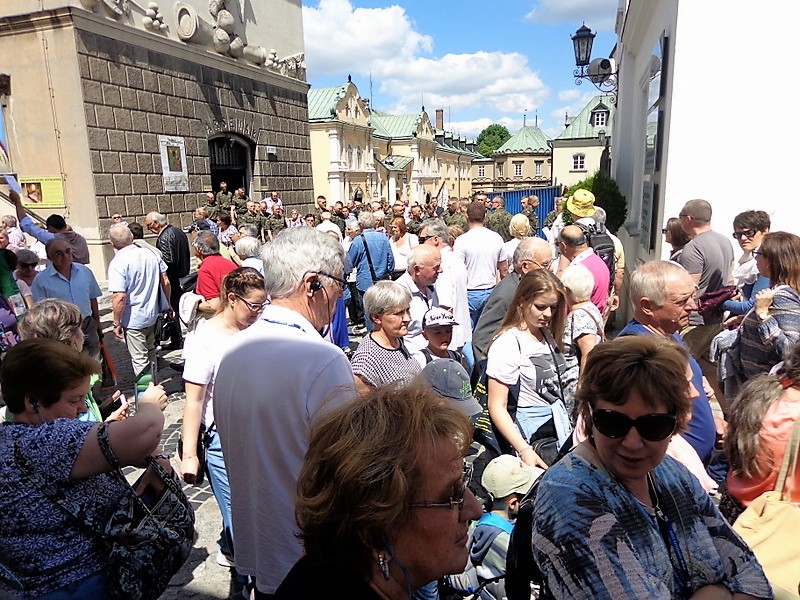
Jasna Góra was an extremely crowded as it is a place of pilgrimage.
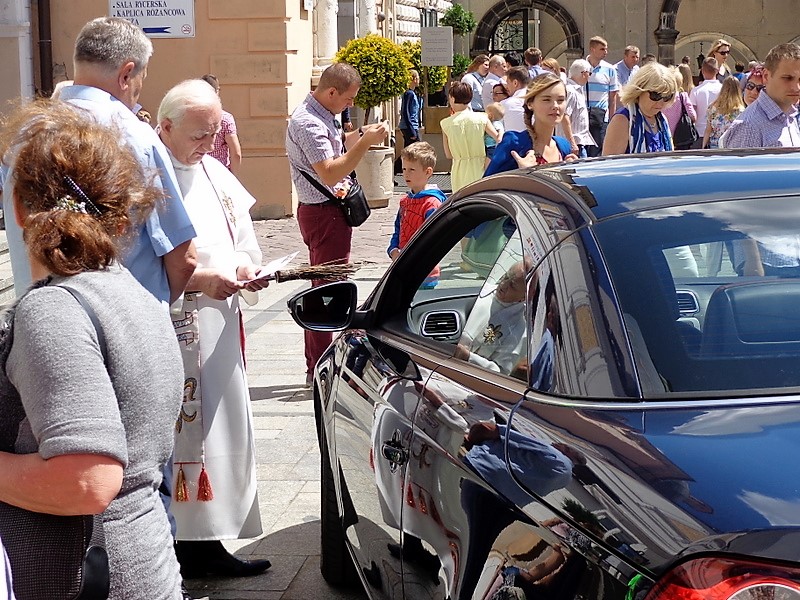 We had to wait a few minutes for a priest who was going to be our guide.
While waiting we saw several cars drive in and stop beside the church to
be blessed by a priest. Then we watched these cars back up through the
crowd of pilgrims.
We had to wait a few minutes for a priest who was going to be our guide.
While waiting we saw several cars drive in and stop beside the church to
be blessed by a priest. Then we watched these cars back up through the
crowd of pilgrims.
Our priest/guide arrived and gave us an in-depth tour. We began in
the museum which displayed many gifts of silver, paintings, vestments,
and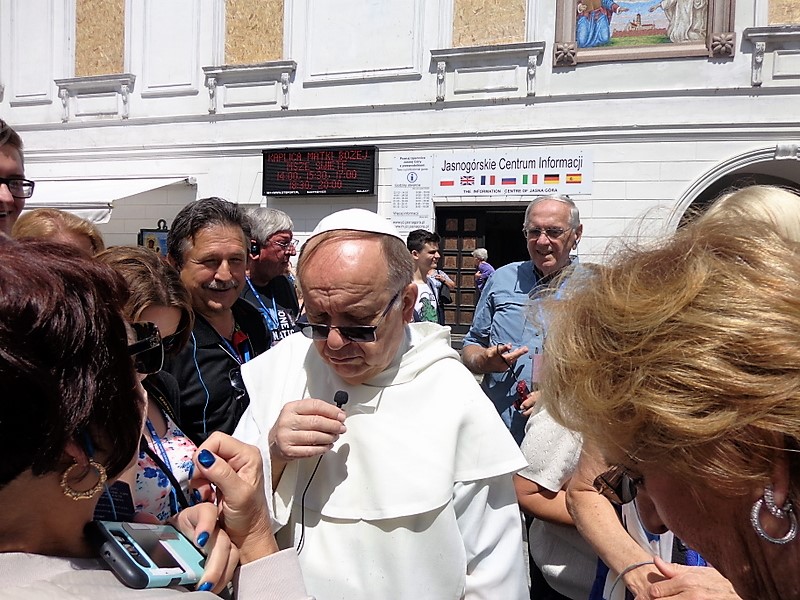 other artifacts. He then took us in the church which was very
Baroque and very crowded. He wanted us to see the Black Madonna, which
is in a separate chapel outside of the church. The priest/guide took us
through the sacristy and through the door next to the altar where a mass
was being said. The small chapel was full, and we “paraded“ up a side
aisle to get a glimpse of the Black Madonna. I know our presence was
very disturbing for those worshiping.
other artifacts. He then took us in the church which was very
Baroque and very crowded. He wanted us to see the Black Madonna, which
is in a separate chapel outside of the church. The priest/guide took us
through the sacristy and through the door next to the altar where a mass
was being said. The small chapel was full, and we “paraded“ up a side
aisle to get a glimpse of the Black Madonna. I know our presence was
very disturbing for those worshiping.
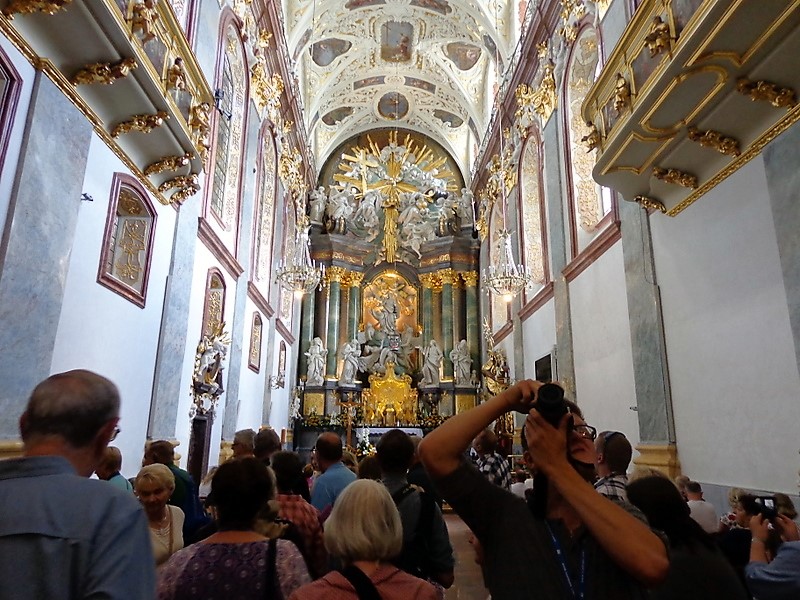
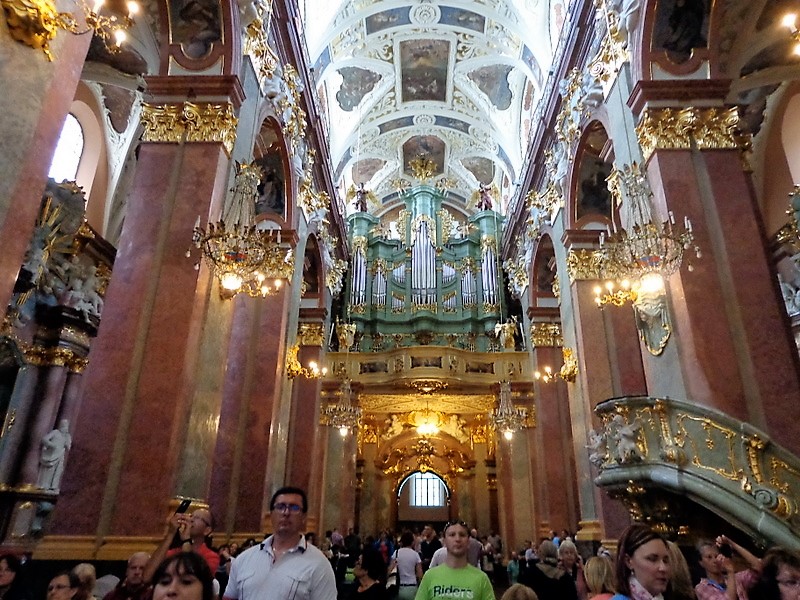

We then went back to the church itself. We were able to take
photos in the church as there was no service going. Later a choir of
young folks presented some music from around the main altar. From there
we went back outside and down stairs to a large gift shop where the
priest/guide began selling masses.
We walked back to our coach and stopped at a local McDonald’s
for lunch. There seems to be at McDonald’s in every city in Europe.
KRAKOW
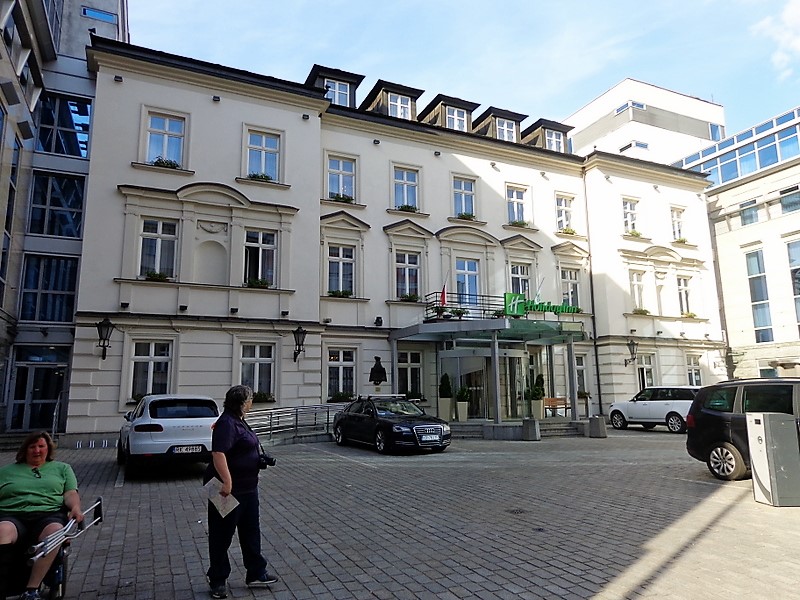 After another several hours on the bus we arrived around 5 o'clock
at the Holiday Inn in Kraków. Kraków is a beautiful city which
sustained no bombing damage during the war.
After another several hours on the bus we arrived around 5 o'clock
at the Holiday Inn in Kraków. Kraków is a beautiful city which
sustained no bombing damage during the war.
One of the oldest cities in Poland, archaeological evidence proves
that there were settlements in the Kracow area as early as the
Palaeolithic period, with stone tools found on Wawel Hill dating back to
50,000BC. Legend attributes the city’s founding to Krakus, the mythical
ruler who vanquished the Wawel Dragon. Historians date the settlement
of Kraków’s Old Town in the 8th century, crediting it to a tribe of
pagan Slavs known as the ‘Vistulans.’ By 966, the date of the first
written record of the city’s name, Kraków had already grown into a busy
commercial center, thanks in part to the amber trade.
In the late 9th century the region was ruled by the Moravians,
passing shortly thereafter to Bohemian rule before being incorporated
into the principality of the Piast dynasty in the 990s, thus creating
the Kingdom of Poland. The city developed rapidly, acquiring its own
bishopric in 1000, and in 1038 Kraków became the capital of Poland, with
Wawel Royal Castle becoming the residence of Polish kings. The 13th
century was marked by several Mongol invasions, the first occurring in
1241 when the city was almost entirely destroyed, but it was rebuilt in
time to be ravaged again in 1259 and 1287. Following this last attack,
the city was surrounded by defensive walls, towers and gates.
Kraków flourished under the rule of Kazimierz the Great
(1333-1370), who expanded Wawel Castle and established two new cities
which were closely connected with and would later be incorporated into
Kraków. A huge patron of the arts and sciences, in 1364 he founded the
Kraków Academy, now known as Jagiellonian University. – one of the
oldest institutions of higher learning in Europe.
The 17th century was marked by the pillaging of the Swedish
Invasion (1655) and a bout with the 'Black Death' that claimed 20,000
residents.
When the First World War broke out, Kraków was besieged by Russian
troops forcing many residents to flee the city. Kraków became the
first Polish city liberated from Austrian rule in 1918. The Treaty of
V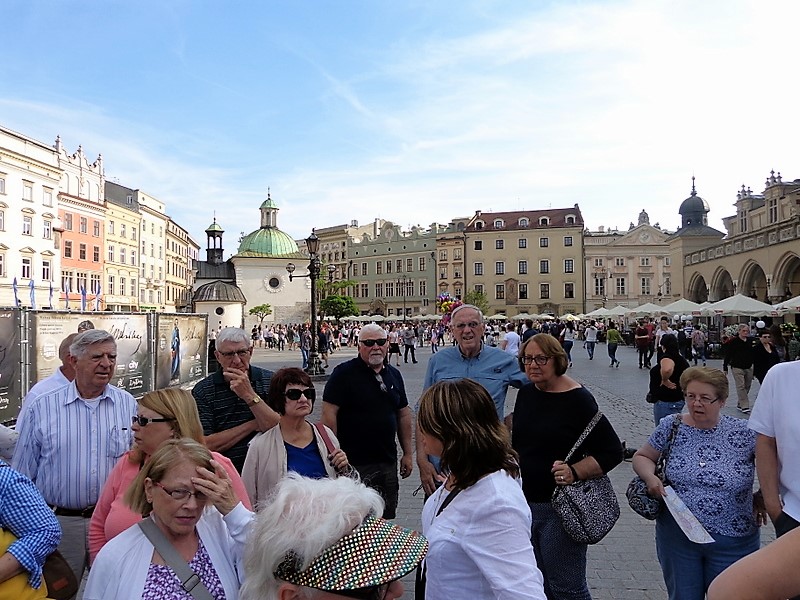 ersailles would establish the first sovereign Polish state in over a
century, however twenty years later in September 1939, Nazi German
forces entered Kraków, setting up command of their ‘General Government’
in Wawel Castle. Over 150 professors from Jagiellonian University were
rounded up and shipped to concentration camps. The Jewish ghetto whose
population fluctuated between 15,000 and 18,000, was liquidated in 1943
with its occupants shot where they stood, sent to work in Płaszów or
sent to their deaths in nearby Auschwitz. Kraków was liberate
ersailles would establish the first sovereign Polish state in over a
century, however twenty years later in September 1939, Nazi German
forces entered Kraków, setting up command of their ‘General Government’
in Wawel Castle. Over 150 professors from Jagiellonian University were
rounded up and shipped to concentration camps. The Jewish ghetto whose
population fluctuated between 15,000 and 18,000, was liquidated in 1943
with its occupants shot where they stood, sent to work in Płaszów or
sent to their deaths in nearby Auschwitz. Kraków was liberate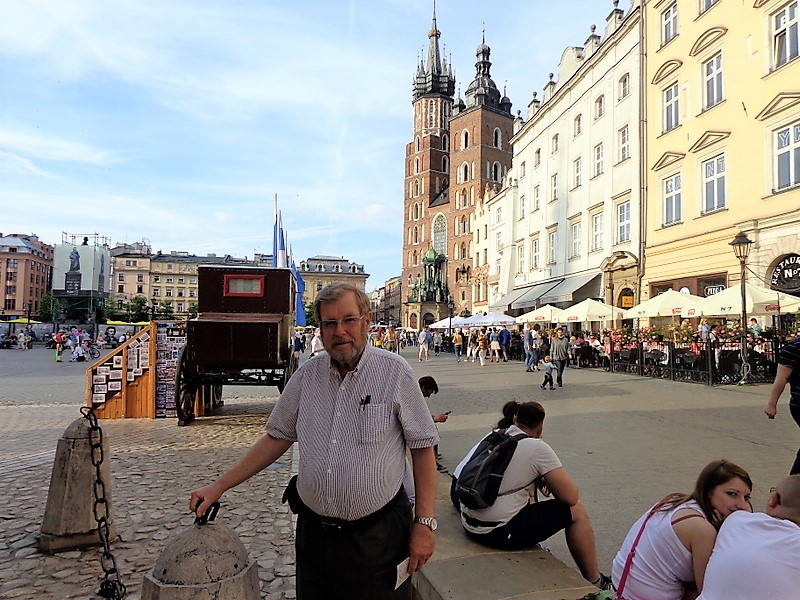 d on
January 18th 1945, with the structures of the city coming through the
Soviet offensive almost completely intact
d on
January 18th 1945, with the structures of the city coming through the
Soviet offensive almost completely intact
In 1978 Kraków’s Old Town and Kazimierz districts were placed on the
first UNESCO World Heritage List and in the same year Kraków’s
archbishop Karol Wojtyla became the first non-Italian pope in 455 years.
Our hotel, the Holiday Inn, is an old palace but modern on the
inside. Our tour manager handed out our room keys, and we settled in for
a very few moments. Our group met in the lobby and walked several
blocks to the Old Town Square which is one of the largest market squares
in the Europe. We were on our own to explore to explore for about an
hour before dinner.
Kraków’s m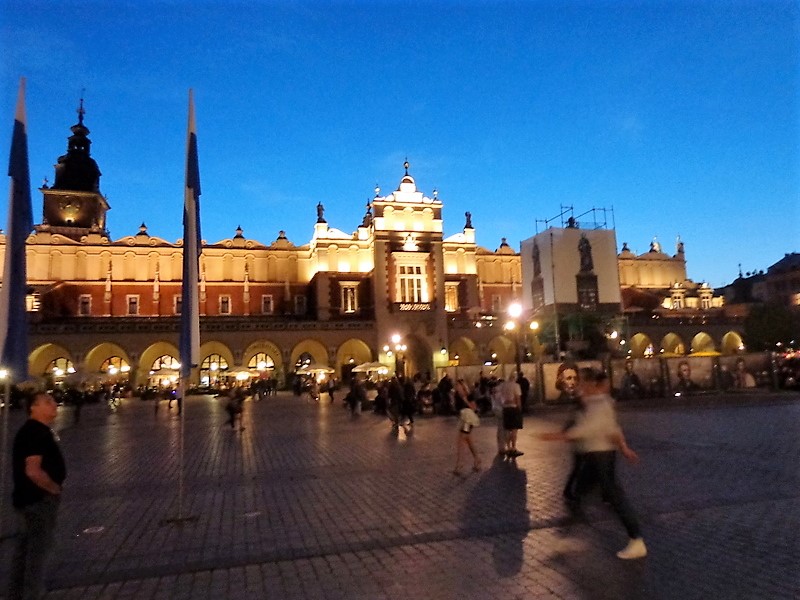 arket square (Rynek) was originally designed in 1257
- the year Kraków was awarded its charter. The grid-like layout of the
Old Town and its central square has changed little since then. In the
center is the large Cloth Hall, built in the 14th century. This huge
hall is filled with merchant stalls selling amber, lace, woodwork, and
souvenirs. We walked through it and resisted the temptation to buy many
beautiful pieces of jewelry and other works of art.
arket square (Rynek) was originally designed in 1257
- the year Kraków was awarded its charter. The grid-like layout of the
Old Town and its central square has changed little since then. In the
center is the large Cloth Hall, built in the 14th century. This huge
hall is filled with merchant stalls selling amber, lace, woodwork, and
souvenirs. We walked through it and resisted the temptation to buy many
beautiful pieces of jewelry and other works of art.
ST. MARY'S BASILICA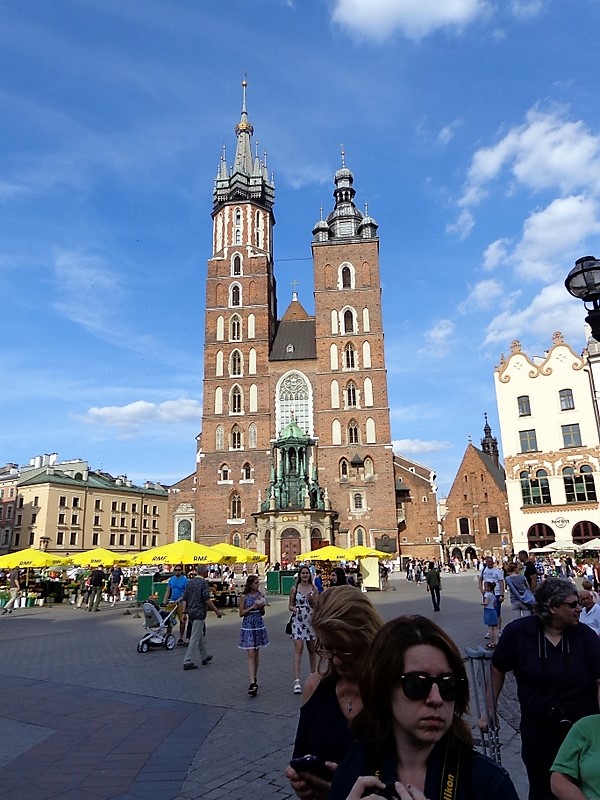
Across from Cloth Hall is the magnificent St. Mary’s Basilica. I
have a model which I have not built yet. We went in the beautiful
baroque interior, but were not allowed to take photos. The blue walls
with gold trim, the altarpiece, stained glass windows of the nave, and
the blue, starred ceiling are magnificent.
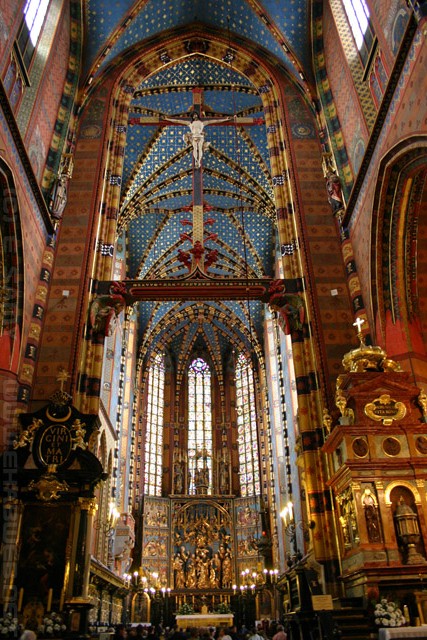
After Tartar raids in the 13th century left the original church in a
heap of ruins, St. Mary’s was rebuilt in Gothic style on the existing
foundations and consecrated in 1320. In the early 15th century, the
towers were built in the two styles which we see today. The northern
tower was raised to 265 feet and was made into a watchtower for the
city.
According to a popular 20th-century legend, during a Mongol
invasion of Poland around 1241, as the Mongol troops approached Krakow.
A sentry on a tower of sounded the alarm by playing the Hejnał, and the
city gates were closed before the Tatars could ambush the city.
 The
trumpeter, however, was shot with an arrow in his throat and did not
complete the anthem, and this is the legendary reason as to why the
trumpet is played from the left tower upper window every hour of the
day. The trumpet stops suddenly in the middle of the song symbolizing
his being shot in the throat. However, the trumpet is played in all four
directions each hour. Note the trumpet at the top center window in
photo above.
The
trumpeter, however, was shot with an arrow in his throat and did not
complete the anthem, and this is the legendary reason as to why the
trumpet is played from the left tower upper window every hour of the
day. The trumpet stops suddenly in the middle of the song symbolizing
his being shot in the throat. However, the trumpet is played in all four
directions each hour. Note the trumpet at the top center window in
photo above.
Our group assembled in front of the Cloth Hall and walked to the
Restauracja Tradycyja in the next block. We were taken down to a
beautiful brick cellar where we had a traditional Polish dinner. We were
seated at long tables and served family style for a five course meal.
The food was very g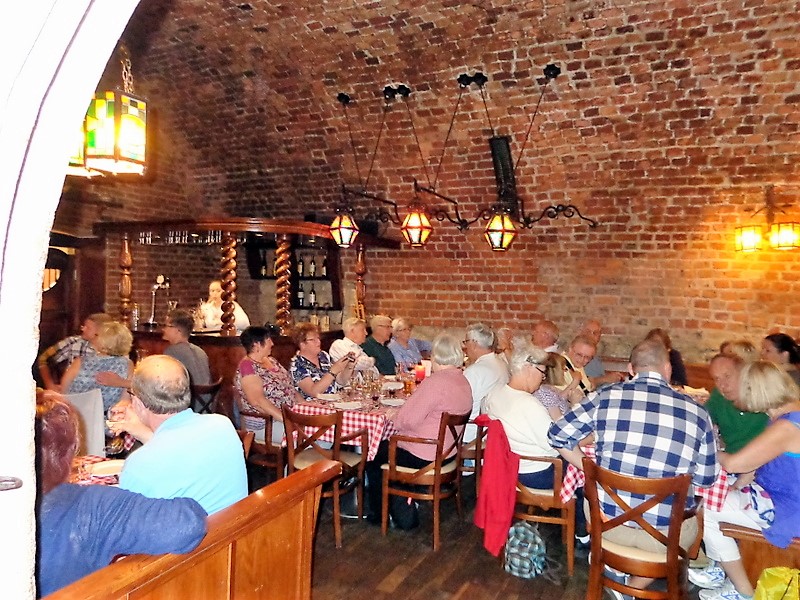 ood. We had entertainment provided by Lajkfolks, a
group of three musicians – bass guitar, an accordion and a clarinet plus
three dancers inauthentic costumes. Several times dancers would grab
someone from the audience to participate. Both of us were chosen along
with several other people for one of the dances. It was a lot of fun.
Our family and friends back home had no ideas that we were Polish
dancers.
ood. We had entertainment provided by Lajkfolks, a
group of three musicians – bass guitar, an accordion and a clarinet plus
three dancers inauthentic costumes. Several times dancers would grab
someone from the audience to participate. Both of us were chosen along
with several other people for one of the dances. It was a lot of fun.
Our family and friends back home had no ideas that we were Polish
dancers.
We walked back to our hotel and were very ready for a good
night’s sleep. We have two days in Kraków. It certainly is lovely.
Next Day
Day 13 coming soon

 In
the first half of the 17th century, kings of the House of Vasa turned
the Jasna Gora Monastery into a modern Dutch-style fortress, which was
one of the pockets of Polish resistance against the Swedish armies
during Swedish invasion of Poland in 1655. The town of Częstochowa
itself was almost completely destroyed by Swedish soldiers.
In
the first half of the 17th century, kings of the House of Vasa turned
the Jasna Gora Monastery into a modern Dutch-style fortress, which was
one of the pockets of Polish resistance against the Swedish armies
during Swedish invasion of Poland in 1655. The town of Częstochowa
itself was almost completely destroyed by Swedish soldiers.  ccording
to tradition, the icon of Jasna Góra was painted by the Luke the
evangelist on a tabletop built by Jesus himself, and the icon was
discovered by St. Helena, mother of Emperor Constantine and collector of
Christian relics in the Holy Land. The icon was then enshrined in the
imperial city of Constantinople according to the legend, where it
remained for the next 500 years.
ccording
to tradition, the icon of Jasna Góra was painted by the Luke the
evangelist on a tabletop built by Jesus himself, and the icon was
discovered by St. Helena, mother of Emperor Constantine and collector of
Christian relics in the Holy Land. The icon was then enshrined in the
imperial city of Constantinople according to the legend, where it
remained for the next 500 years. It is said that when the monks pulled the icon from the mud, a
miraculous fountain appeared, which they used to clean the painting. The
icon was repainted in Krakow, but both the arrow mark and the gashes
from the sword were left and remain clearly visible today.
It is said that when the monks pulled the icon from the mud, a
miraculous fountain appeared, which they used to clean the painting. The
icon was repainted in Krakow, but both the arrow mark and the gashes
from the sword were left and remain clearly visible today.  Directly
in front of the church is a one-story building which houses some guest
apartments and the information office, (#11)thus there is no front
entrance.
Directly
in front of the church is a one-story building which houses some guest
apartments and the information office, (#11)thus there is no front
entrance.  on each side, that mark
the passage of each 15 minutes with Marian melodies.
on each side, that mark
the passage of each 15 minutes with Marian melodies.  We had to wait a few minutes for a priest who was going to be our guide.
While waiting we saw several cars drive in and stop beside the church to
be blessed by a priest. Then we watched these cars back up through the
crowd of pilgrims.
We had to wait a few minutes for a priest who was going to be our guide.
While waiting we saw several cars drive in and stop beside the church to
be blessed by a priest. Then we watched these cars back up through the
crowd of pilgrims.  other artifacts. He then took us in the church which was very
Baroque and very crowded. He wanted us to see the Black Madonna, which
is in a separate chapel outside of the church. The priest/guide took us
through the sacristy and through the door next to the altar where a mass
was being said. The small chapel was full, and we “paraded“ up a side
aisle to get a glimpse of the Black Madonna. I know our presence was
very disturbing for those worshiping.
other artifacts. He then took us in the church which was very
Baroque and very crowded. He wanted us to see the Black Madonna, which
is in a separate chapel outside of the church. The priest/guide took us
through the sacristy and through the door next to the altar where a mass
was being said. The small chapel was full, and we “paraded“ up a side
aisle to get a glimpse of the Black Madonna. I know our presence was
very disturbing for those worshiping.  After another several hours on the bus we arrived around 5 o'clock
at the Holiday Inn in Kraków. Kraków is a beautiful city which
sustained no bombing damage during the war.
After another several hours on the bus we arrived around 5 o'clock
at the Holiday Inn in Kraków. Kraków is a beautiful city which
sustained no bombing damage during the war.  ersailles would establish the first sovereign Polish state in over a
century, however twenty years later in September 1939, Nazi German
forces entered Kraków, setting up command of their ‘General Government’
in Wawel Castle. Over 150 professors from Jagiellonian University were
rounded up and shipped to concentration camps. The Jewish ghetto whose
population fluctuated between 15,000 and 18,000, was liquidated in 1943
with its occupants shot where they stood, sent to work in Płaszów or
sent to their deaths in nearby Auschwitz. Kraków was liberate
ersailles would establish the first sovereign Polish state in over a
century, however twenty years later in September 1939, Nazi German
forces entered Kraków, setting up command of their ‘General Government’
in Wawel Castle. Over 150 professors from Jagiellonian University were
rounded up and shipped to concentration camps. The Jewish ghetto whose
population fluctuated between 15,000 and 18,000, was liquidated in 1943
with its occupants shot where they stood, sent to work in Płaszów or
sent to their deaths in nearby Auschwitz. Kraków was liberate d on
January 18th 1945, with the structures of the city coming through the
Soviet offensive almost completely intact
d on
January 18th 1945, with the structures of the city coming through the
Soviet offensive almost completely intact arket square (Rynek) was originally designed in 1257
- the year Kraków was awarded its charter. The grid-like layout of the
Old Town and its central square has changed little since then. In the
center is the large Cloth Hall, built in the 14th century. This huge
hall is filled with merchant stalls selling amber, lace, woodwork, and
souvenirs. We walked through it and resisted the temptation to buy many
beautiful pieces of jewelry and other works of art.
arket square (Rynek) was originally designed in 1257
- the year Kraków was awarded its charter. The grid-like layout of the
Old Town and its central square has changed little since then. In the
center is the large Cloth Hall, built in the 14th century. This huge
hall is filled with merchant stalls selling amber, lace, woodwork, and
souvenirs. We walked through it and resisted the temptation to buy many
beautiful pieces of jewelry and other works of art. 
 The
trumpeter, however, was shot with an arrow in his throat and did not
complete the anthem, and this is the legendary reason as to why the
trumpet is played from the left tower upper window every hour of the
day. The trumpet stops suddenly in the middle of the song symbolizing
his being shot in the throat. However, the trumpet is played in all four
directions each hour. Note the trumpet at the top center window in
photo above.
The
trumpeter, however, was shot with an arrow in his throat and did not
complete the anthem, and this is the legendary reason as to why the
trumpet is played from the left tower upper window every hour of the
day. The trumpet stops suddenly in the middle of the song symbolizing
his being shot in the throat. However, the trumpet is played in all four
directions each hour. Note the trumpet at the top center window in
photo above.
.jpg)
